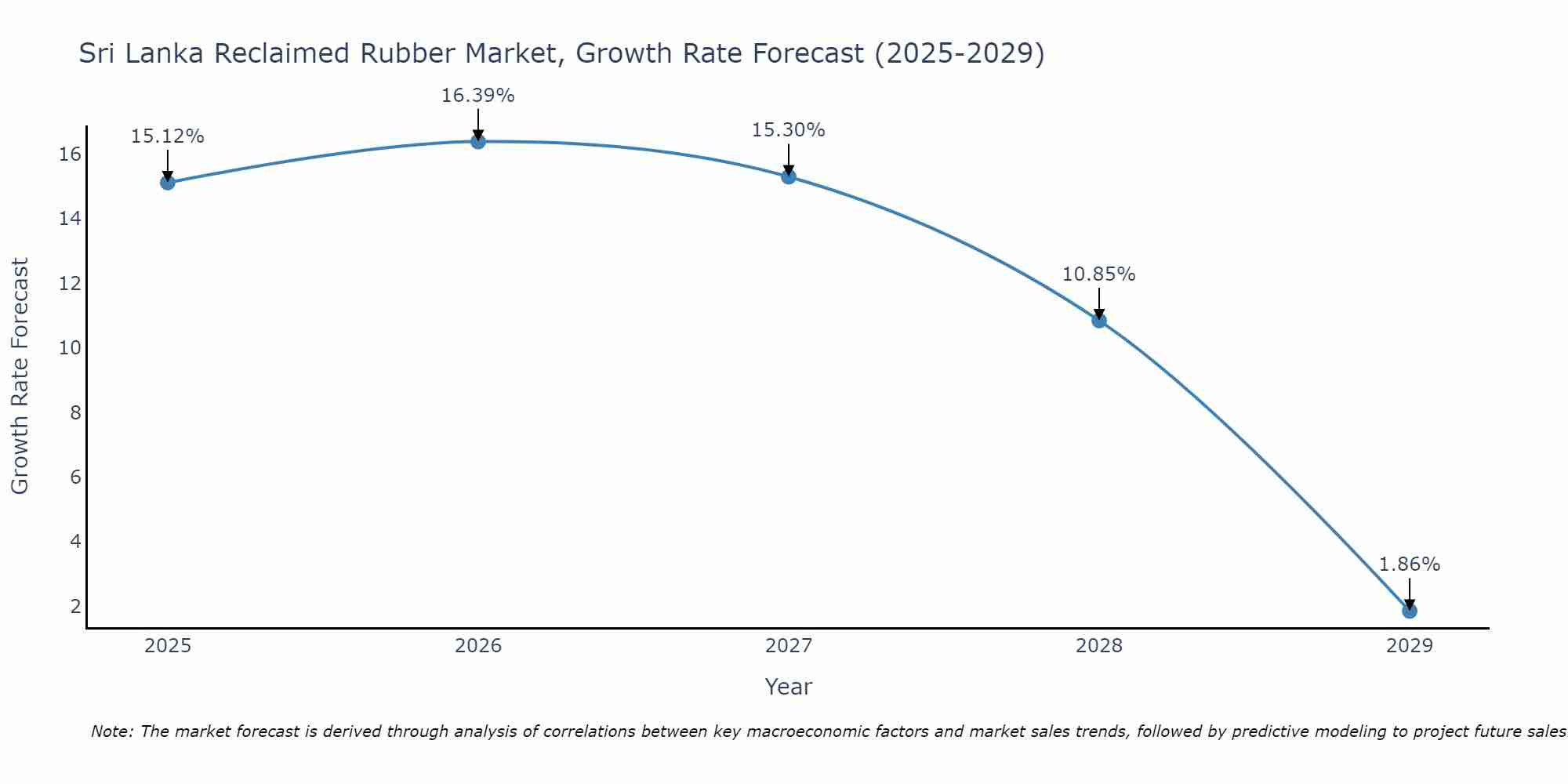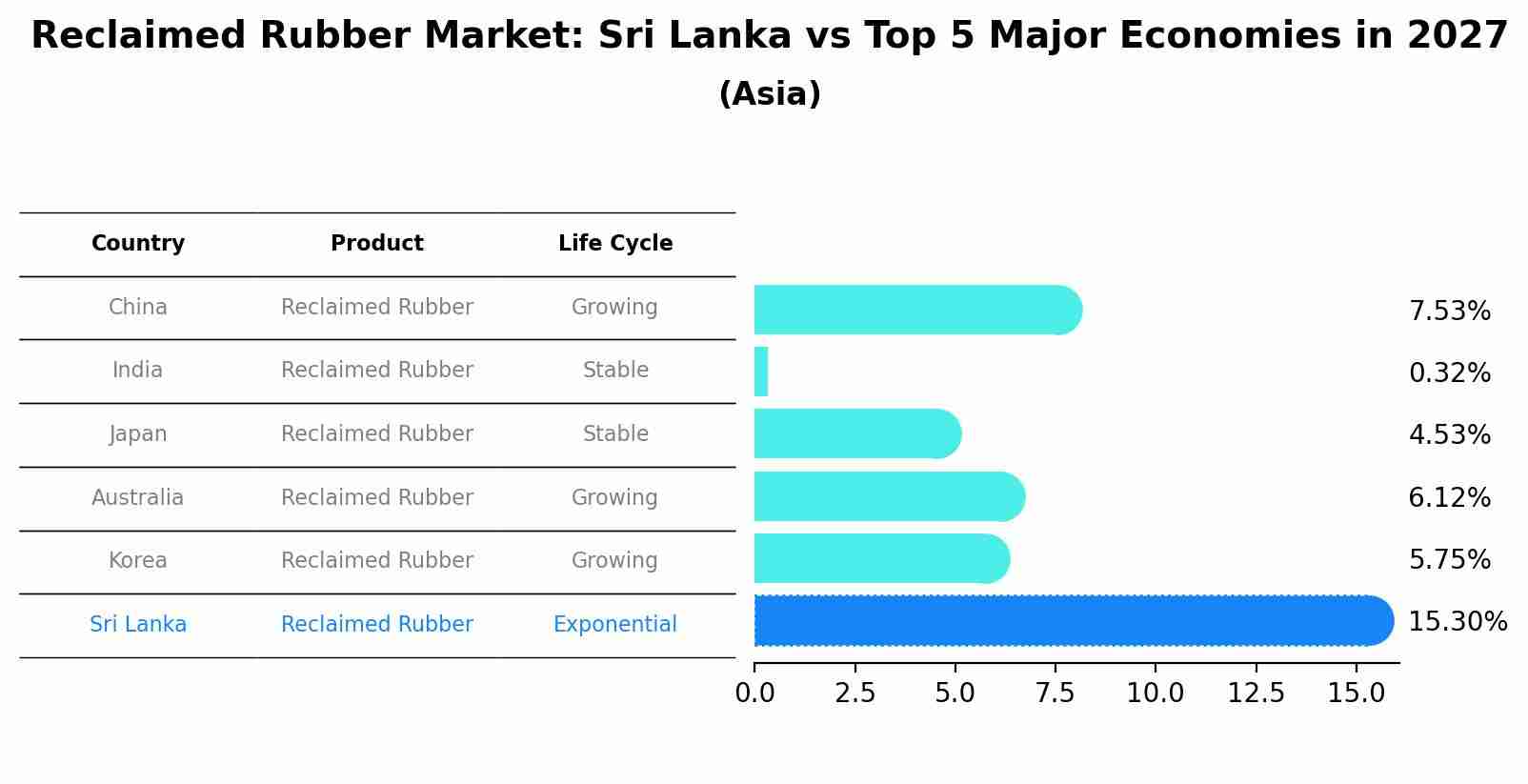Sri Lanka Reclaimed Rubber Market Outlook | COVID-19 IMPACT, Companies, Revenue, Value, Analysis, Share, Growth, Trends, Size, Forecast & Industry
| Product Code: ETC096230 | Publication Date: Jun 2021 | Updated Date: Apr 2025 | Product Type: Report | |
| Publisher: 6Wresearch | No. of Pages: 70 | No. of Figures: 35 | No. of Tables: 5 | |
Sri Lanka Reclaimed Rubber Market Size Growth Rate
The Sri Lanka Reclaimed Rubber Market is projected to witness mixed growth rate patterns during 2025 to 2029. The growth rate begins at 15.12% in 2025, climbs to a high of 16.39% in 2026, and moderates to 1.86% by 2029.

Reclaimed Rubber Market: Sri Lanka vs Top 5 Major Economies in 2027 (Asia)
By 2027, the Reclaimed Rubber market in Sri Lanka is anticipated to reach a growth rate of 15.30%, as part of an increasingly competitive Asia region, where China remains at the forefront, supported by India, Japan, Australia and South Korea, driving innovations and market adoption across sectors.

Sri Lanka Reclaimed Rubber Market Overview
The reclaimed rubber market in Sri Lanka is thriving due to the increasing focus on sustainability and cost efficiency in the rubber industry. Reclaimed rubber is used in various applications, including tires, footwear, and industrial products, offering a cost-effective and environmentally friendly alternative to virgin rubber. The market benefits from the abundant availability of raw materials and supportive government policies promoting recycling.
Drivers of the market
The reclaimed rubber market in Sri Lanka is driven by environmental sustainability initiatives and regulatory pressures to reduce carbon footprint. Reclaimed rubber offers cost-effective alternatives to virgin rubber in industries such as automotive, construction, and footwear. Market growth is supported by advancements in rubber recycling technologies, increasing awareness of resource conservation, and incentives for using eco-friendly materials. Demand is also influenced by manufacturers` efforts to improve product performance and meet stringent quality standards.
Challenges of the market
The Sri Lanka Reclaimed Rubber Market faces challenges such as the high cost of raw materials and processing equipment, which can be prohibitive for smaller manufacturers. Additionally, there are regulatory and environmental requirements related to the production and disposal of reclaimed rubber, increasing the complexity and cost of operations. The market also deals with issues related to the availability of skilled labor and technical expertise required for the production and quality control of reclaimed rubber. Ensuring the quality and consistency of reclaimed rubber products in various applications is another significant challenge. The market also needs to address issues related to competition from alternative rubber products that offer similar properties at lower costs.
Government Policy of the market
Policies governing the reclaimed rubber market in Sri Lanka focus on sustainable waste management and environmental conservation. Regulations encourage the recycling of rubber products and the use of reclaimed rubber in various applications. The government provides incentives for companies that adopt eco-friendly practices and technologies to minimize environmental impact.
Key Highlights of the Report:
- Sri Lanka Reclaimed Rubber Market Outlook
- Market Size of Sri Lanka Reclaimed Rubber Market, 2020
- Forecast of Sri Lanka Reclaimed Rubber Market, 2027
- Historical Data and Forecast of Sri Lanka Reclaimed Rubber Revenues & Volume for the Period 2018 - 2027
- Sri Lanka Reclaimed Rubber Market Trend Evolution
- Sri Lanka Reclaimed Rubber Market Drivers and Challenges
- Sri Lanka Reclaimed Rubber Price Trends
- Sri Lanka Reclaimed Rubber Porter's Five Forces
- Sri Lanka Reclaimed Rubber Industry Life Cycle
- Historical Data and Forecast of Sri Lanka Reclaimed Rubber Market Revenues & Volume By Product for the Period 2018 - 2027
- Historical Data and Forecast of Sri Lanka Reclaimed Rubber Market Revenues & Volume By Whole Tire Reclaim (WTR) for the Period 2018 - 2027
- Historical Data and Forecast of Sri Lanka Reclaimed Rubber Market Revenues & Volume By Butyl Reclaim for the Period 2018 - 2027
- Historical Data and Forecast of Sri Lanka Reclaimed Rubber Market Revenues & Volume By EPDM for the Period 2018 - 2027
- Historical Data and Forecast of Sri Lanka Reclaimed Rubber Market Revenues & Volume By Drab & Colored for the Period 2018 - 2027
- Historical Data and Forecast of Sri Lanka Reclaimed Rubber Market Revenues & Volume By Others for the Period 2018 - 2027
- Historical Data and Forecast of Sri Lanka Reclaimed Rubber Market Revenues & Volume By Application for the Period 2018 - 2027
- Historical Data and Forecast of Sri Lanka Reclaimed Rubber Market Revenues & Volume By Automotive & Aircraft Tires for the Period 2018 - 2027
- Historical Data and Forecast of Sri Lanka Reclaimed Rubber Market Revenues & Volume By Cycle Tires for the Period 2018 - 2027
- Historical Data and Forecast of Sri Lanka Reclaimed Rubber Market Revenues & Volume By Retreading for the Period 2018 - 2027
- Historical Data and Forecast of Sri Lanka Reclaimed Rubber Market Revenues & Volume By Belts & Hoses for the Period 2018 - 2027
- Historical Data and Forecast of Sri Lanka Reclaimed Rubber Market Revenues & Volume By Footwear for the Period 2018 - 2027
- Historical Data and Forecast of Sri Lanka Reclaimed Rubber Market Revenues & Volume By Molded Goods for the Period 2018 - 2027
- Historical Data and Forecast of Sri Lanka Reclaimed Rubber Market Revenues & Volume By Others for the Period 2018 - 2027
- Sri Lanka Reclaimed Rubber Import Export Trade Statistics
- Market Opportunity Assessment By Product
- Market Opportunity Assessment By Application
- Sri Lanka Reclaimed Rubber Top Companies Market Share
- Sri Lanka Reclaimed Rubber Competitive Benchmarking By Technical and Operational Parameters
- Sri Lanka Reclaimed Rubber Company Profiles
- Sri Lanka Reclaimed Rubber Key Strategic Recommendations
Frequently Asked Questions About the Market Study (FAQs):
1 Executive Summary |
2 Introduction |
2.1 Key Highlights of the Report |
2.2 Report Description |
2.3 Market Scope & Segmentation |
2.4 Research Methodology |
2.5 Assumptions |
3 Sri Lanka Reclaimed Rubber Market Overview |
3.1 Sri Lanka Country Macro Economic Indicators |
3.2 Sri Lanka Reclaimed Rubber Market Revenues & Volume, 2020 & 2027F |
3.3 Sri Lanka Reclaimed Rubber Market - Industry Life Cycle |
3.4 Sri Lanka Reclaimed Rubber Market - Porter's Five Forces |
3.5 Sri Lanka Reclaimed Rubber Market Revenues & Volume Share, By Product, 2020 & 2027F |
3.6 Sri Lanka Reclaimed Rubber Market Revenues & Volume Share, By Application, 2020 & 2027F |
4 Sri Lanka Reclaimed Rubber Market Dynamics |
4.1 Impact Analysis |
4.2 Market Drivers |
4.3 Market Restraints |
5 Sri Lanka Reclaimed Rubber Market Trends |
6 Sri Lanka Reclaimed Rubber Market, By Types |
6.1 Sri Lanka Reclaimed Rubber Market, By Product |
6.1.1 Overview and Analysis |
6.1.2 Sri Lanka Reclaimed Rubber Market Revenues & Volume, By Product, 2018 - 2027F |
6.1.3 Sri Lanka Reclaimed Rubber Market Revenues & Volume, By Whole Tire Reclaim (WTR), 2018 - 2027F |
6.1.4 Sri Lanka Reclaimed Rubber Market Revenues & Volume, By Butyl Reclaim, 2018 - 2027F |
6.1.5 Sri Lanka Reclaimed Rubber Market Revenues & Volume, By EPDM, 2018 - 2027F |
6.1.6 Sri Lanka Reclaimed Rubber Market Revenues & Volume, By Drab & Colored, 2018 - 2027F |
6.1.7 Sri Lanka Reclaimed Rubber Market Revenues & Volume, By Others, 2018 - 2027F |
6.2 Sri Lanka Reclaimed Rubber Market, By Application |
6.2.1 Overview and Analysis |
6.2.2 Sri Lanka Reclaimed Rubber Market Revenues & Volume, By Automotive & Aircraft Tires, 2018 - 2027F |
6.2.3 Sri Lanka Reclaimed Rubber Market Revenues & Volume, By Cycle Tires, 2018 - 2027F |
6.2.4 Sri Lanka Reclaimed Rubber Market Revenues & Volume, By Retreading, 2018 - 2027F |
6.2.5 Sri Lanka Reclaimed Rubber Market Revenues & Volume, By Belts & Hoses, 2018 - 2027F |
6.2.6 Sri Lanka Reclaimed Rubber Market Revenues & Volume, By Footwear, 2018 - 2027F |
6.2.7 Sri Lanka Reclaimed Rubber Market Revenues & Volume, By Molded Goods, 2018 - 2027F |
7 Sri Lanka Reclaimed Rubber Market Import-Export Trade Statistics |
7.1 Sri Lanka Reclaimed Rubber Market Export to Major Countries |
7.2 Sri Lanka Reclaimed Rubber Market Imports from Major Countries |
8 Sri Lanka Reclaimed Rubber Market Key Performance Indicators |
9 Sri Lanka Reclaimed Rubber Market - Opportunity Assessment |
9.1 Sri Lanka Reclaimed Rubber Market Opportunity Assessment, By Product, 2020 & 2027F |
9.2 Sri Lanka Reclaimed Rubber Market Opportunity Assessment, By Application, 2020 & 2027F |
10 Sri Lanka Reclaimed Rubber Market - Competitive Landscape |
10.1 Sri Lanka Reclaimed Rubber Market Revenue Share, By Companies, 2020 |
10.2 Sri Lanka Reclaimed Rubber Market Competitive Benchmarking, By Operating and Technical Parameters |
11 Company Profiles |
12 Recommendations |
13 Disclaimer |
- Single User License$ 1,995
- Department License$ 2,400
- Site License$ 3,120
- Global License$ 3,795
Search
Related Reports
- Australia IT Asset Disposal Market (2025-2031) | Strategy, Consumer Insights, Analysis, Investment Trends, Opportunities, Growth, Size, Share, Industry, Revenue, Segments, Value, Segmentation, Supply, Forecast, Restraints, Outlook, Competition, Drivers, Trends, Demand, Pricing Analysis, Competitive, Strategic Insights, Companies, Challenges
- UAE Building Thermal Insulation Market Outlook (2025-2031) | Revenue, Companies, Share, Trends, Growth, Size, Forecast, Industry, Analysis & Value
- Portugal Electronic Document Management Market (2025-2031) | Strategy, Consumer Insights, Analysis, Investment Trends, Opportunities, Growth, Size, Share, Industry, Revenue, Segments, Value, Segmentation, Supply, Forecast, Restraints, Outlook, Competition, Drivers, Trends, Demand, Pricing Analysis, Competitive, Strategic Insights, Companies, Challenges
- France Electronic Document Management Market (2025-2031) | Strategy, Consumer Insights, Analysis, Investment Trends, Opportunities, Growth, Size, Share, Industry, Revenue, Segments, Value, Segmentation, Supply, Forecast, Restraints, Outlook, Competition, Drivers, Trends, Demand, Pricing Analysis, Competitive, Strategic Insights, Companies, Challenges
- Portugal Occupational Health & Safety Services Market (2025-2031) | Strategy, Consumer Insights, Analysis, Investment Trends, Opportunities, Growth, Size, Share, Industry, Revenue, Segments, Value, Segmentation, Supply, Forecast, Restraints, Outlook, Competition, Drivers, Trends, Demand, Pricing Analysis, Competitive, Strategic Insights, Companies, Challenges
- Netherlands Occupational Health and Safety Services Market (2025-2031) | Strategy, Consumer Insights, Analysis, Investment Trends, Opportunities, Growth, Size, Share, Industry, Revenue, Segments, Value, Segmentation, Supply, Forecast, Restraints, Outlook, Competition, Drivers, Trends, Demand, Pricing Analysis, Competitive, Strategic Insights, Companies, Challenges
- Belgium and Luxembourg Facility Management Market (2025-2031) | Strategy, Consumer Insights, Analysis, Investment Trends, Opportunities, Growth, Size, Share, Industry, Revenue, Segments, Value, Segmentation, Supply, Forecast, Restraints, Outlook, Competition, Drivers, Trends, Demand, Pricing Analysis, Competitive, Strategic Insights, Companies, Challenges
- Russia Women Intimate Apparel Market (2025-2031) | Strategy, Consumer Insights, Analysis, Investment Trends, Opportunities, Growth, Size, Share, Industry, Revenue, Segments, Value, Segmentation, Supply, Forecast, Restraints, Outlook, Competition, Drivers, Trends, Demand, Pricing Analysis, Competitive, Strategic Insights, Companies, Challenges
- Africa Chocolate Market (2025-2031) | Size, Share, Trends, Growth, Revenue, Analysis, Forecast, industry & Outlook
- Global Hydroxychloroquine And Chloroquine Market (2025-2031) | Industry, Trends, Size, Outlook, Growth, Value, Companies, Revenue, Analysis, Share, Forecast
Industry Events and Analyst Meet
Our Clients
Whitepaper
- Middle East & Africa Commercial Security Market Click here to view more.
- Middle East & Africa Fire Safety Systems & Equipment Market Click here to view more.
- GCC Drone Market Click here to view more.
- Middle East Lighting Fixture Market Click here to view more.
- GCC Physical & Perimeter Security Market Click here to view more.
6WResearch In News
- Doha a strategic location for EV manufacturing hub: IPA Qatar
- Demand for luxury TVs surging in the GCC, says Samsung
- Empowering Growth: The Thriving Journey of Bangladesh’s Cable Industry
- Demand for luxury TVs surging in the GCC, says Samsung
- Video call with a traditional healer? Once unthinkable, it’s now common in South Africa
- Intelligent Buildings To Smooth GCC’s Path To Net Zero













